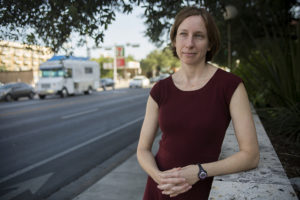The mayor’s bond proposal is the “Smart Corridor Resolution.” So, what makes a street smart?
Wednesday, June 22, 2016 by
Audrey McGlinchy, KUT Cars, buses and trucks idle at the four-way intersection at Guadalupe Street and West Dean Keeton Street. A horde of prospective students takes to the crosswalk, the timer counting down. Traverse this intersection long enough and you might soon understand its varied pains: lights that are never green long enough and minimal crosswalks for a part of town draped with student pedestrians.
Mayor Steve Adler might classify this street, in its current state, as “stupid.” Jen Duthie, a researcher with the Center for Transportation Research at the University of Texas, is a little more forgiving.
“I wouldn’t say it’s a dumb corridor,” she said, while shouting over the din of an accelerating truck. “I would say it’s a pretty traditional corridor. … It definitely has potential for a lot of improvements, and I think that’s what the mayor is hoping to do through his bond proposal.”
When first introduced, Adler’s mobility bond proposal was dubbed the “Smart Corridor Resolution.” (Since that announcement more than a week ago, he seems to have renamed it the “Go Big Corridor Resolution.”) But while this phrase is not unique to Austin, the mayor’s literal use of the word “smart” may be.
As part of a project on an interstate in Northern California, state officials used “smart” as an acronym, meaning “Safety, Mobility and Automated Real-Time Traffic Management.” But Adler said his use just means smart road design.
“It means that you do things like putting right and left turn lanes at the intersection so that people aren’t caught behind cars that are turning,” he said. “You put medians down the street so that cars are not turning left in the middle of a block that everybody piles up behind.”
Other ideas include pull-offs for buses, so that stopping to pick up riders doesn’t mean clogging traffic, as well as protected bike lanes. In the same way that a smartphone offers a user more options than, say, a flip phone, the mayor’s idea of a “smart corridor” goes beyond streets that could feel nicer to drive along.
“You want to develop these streets in ways that are more complete, that have more mixed-income housing, that have more small businesses and the ability for people to be able to safely find what they need in a closer proximity to where they are,” he said.

Jen Duthie stands at the intersection of West Dean Keeton and Guadalupe. Photo by Miguel Gutierrez Jr./KUT News.
Plus, better technology — like adaptive signal control.
“What adaptive signal technology lets you do is have the timing plans be responsive to the traffic and potentially the multimodal traffic,” said Duthie. “So adjusting the green times such that you’re not waiting at a red light while no one is coming in the opposite direction.”
City Council members will continue to hash out at least four bond proposals on the table at their meeting on Thursday. Staff recommends settling on one proposal this week, since Council breaks for the month of July and ballot language is due at the end of August.
This story is the result of a partnership between the Austin Monitor and KUT News.
Top photo: Pedestrian crosswalk at Dean Keaton Street and Guadalupe Street by Miguel Gutierrez Jr./KUT News.
You're a community leader
And we’re honored you look to us for serious, in-depth news. You know a strong community needs local and dedicated watchdog reporting. We’re here for you and that won’t change. Now will you take the powerful next step and support our nonprofit news organization?










